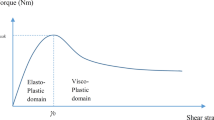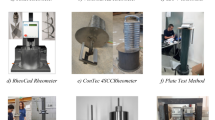Abstract
A deeper and wider knowledge of the rheology of concrete could be obtained if a variety of absolute rheological parameters were measured. Although a valuable rheological classification can be induced from concrete rheometers, they do not give the same absolute values of the rheological parameters. Moreover, rheological tests with concrete require a large volume of material. The aim of this work is to use the concrete equivalent mortar (CEM) method (Schwartzentruber and Catherine, Mater Struct 33:475–482, 2000) to get concrete rheological information with an absolute rheometer. Additionally some graph tools that resume the results from several rheological tests are suggested for the design of concretes. CEM have been formulated to test concrete formulations with an absolute rheometer. Steady flow measurements of a CEM corresponding to a self-compacting concrete (SCC) clearly reveal characteristic non-linear viscoplastic behavior which it is not shown by conventional tests used to characterize concretes. The thixotropic behavior of a concrete is well-established using three different rheological tests that can be made with an absolute rheometer testing its corresponding CEM. These tests reveal aspects of the strength and kinetics of the micro-structure that are not observable when thixotropy of concrete is semiquantified with conventional methods. Only with a CEM is possible to make oscillatory shear tests. In this way the viscoelastic behavior of the concrete can be characterized. Results of practical interest are so obtained. For example, the necessity of vibration at rest application to the fresh concrete can be established from frequency sweep tests of CEM in the linear viscoelastic region. The correlation between rheological behaviors of a concrete and its corresponding CEM has been supported. Steady flow and thixotropy rheographs of CEM are suggested as tools for an easy and fast determination of adequate formulation for specific applications.




















Similar content being viewed by others
References
Ferraris CF, Brower L, Ozyildirim C, Daczko J (2000) Workability of self-compacting concrete. In: Proceedings of the international symposium on high performance concrete 2000, Orlando, USA, pp 398–407
Tattersall GH, Banfill PFG (1983) The rheology of fresh concrete. Pitman, London
Ferraris CF, Larrard F, Martys N (2001) Fresh concrete rheology: recent developments. Materials Science of Concrete VI, American Ceramics Society, pp 215–241
Thrane LN, Pade C, Svensson T (2005) Estimation of Bingham rheological parameters of SCC from slump flow measurements. In: Proceedings of nordic concrete research meeting, Oslo, Norway, pp 92–94
Wallevik OH (2004) IBRI at your service: rheological measurements on cement paste, mortar and concrete by use of a coaxial cylinder viscometer. Icelanding Building Research Institute
Kovler K, Roussel N (2011) Properties of fresh and hardened concrete. Cem Concr Res 41:775–792
Roussel N (2006) A theoretical frame to study stability of fresh concrete. Mater Struct 39:81–91
Saak AW, Jenning H, Shah S (2001) New methodology for designing self-compacting concrete. ACI Mater J 98:429–439
Shen L, Struble L, Lange D (2009) Modeling dynamic segregation of self-consolidating concrete. ACI Mater J 106:375–380
Cyr M, Legrand C, Mouret M (2000) Study of the shear-thickening effect of superplasticizers on the rheological behavior of cement pastes containing or not mineral additives. Cem Concr Res 30:1477–1483
Feys D, Verhoeven R, Schutter G (2008) Fresh self-compacting concrete, a shear-thickening material. Cem Concr Res 38:920–929
Larrard F, Ferraris CF, Sedran T (1998) Fresh concrete: a Herschel-Bulkley material. Mater Struct 31:494–498
Feys D, Verhoeven R, Schutter G (2007) Evaluation of time independent rheological models applicable to fresh self-compacting concrete. Appl Rheol 17(56244):1–10
Tchamba JC, Amziane S, Ovarlez G, Roussel N (2008) Lateral stress exerted by fresh cement paste on formwork: laboratory experiments. Cem Concr Res 38:459–466
Lecompte T, Perrot A, Picandet V, Bellegou H, Amziane S (2012) Cement-based mixes: shearing properties and pore pressure. Cem Concr Res 42:139–147
Assaad J, Khayat KH, Mesbah H (2003) Variation of formwork pressure with thixotropy of self-consolidating concrete. ACI Mater J 100:29–37
Ovarlez G, Roussel N (2006) A physical model for the prediction of lateral stress exerted by self-compacting concrete on formwork. Mater Struct 39:269–279
Perrot A, Amziane S, Ovarlez G, Roussel N (2009) SCC formwork pressure: influence of steel rebars. Cem Concr Res 39:524–528
Roussel N (2006) A thixotropy model for fresh fluid concretes: theory, validation and applications. Cem Concr Res 36:1797–1806
Papo A, Caufin B (1991) A study of the hydration process of cement pastes by means of oscillatory rheological techniques. Cem Concr Res 21:1111–1117
Struble LJ, Schultz MA (1993) Using creep and recovery to study flow behavior of fresh cement paste. Cem Concr Res 23:1369–1379
Sun Z, Voigt T, Shah SP (2006) Rheometric and ultrasonic investigations of viscoelastic properties of fresh Portland cement pastes. Cem Concr Res 36:278–287
Ferraris CF, Obla KH, Hill R (2001) The influence of mineral admixtures on the rheology of cement paste and concrete. Cem Concr Res 31:245–255
Flatt RJ, Larosa D, Roussel N (2006) Linking yield stress measurements: spread test versus Viskomat. Cem Concr Res 36:99–109
Larrard F, Sedran T (2002) Mixture-propotioning of high-performance concrete. Cem Concr Res 32:1699–1704
Mahaut F, Mokéddem S, Chateau X, Roussel N, Ovarlez G (2008) Effect of coarse particle volume fraction on the yield stress and thixotropy of cementitious materials. Cem Concr Res 38:1276–1285
Newman J (2002) Advanced concrete technology set. Elsevier, Amsterdam
Yammine J, Chaouche M, Guerinet M, Moranville M, Roussel N (2008) From ordinary rheology concrete to self-compacting concrete: a transition between frictional to hydrodynamic interactions. Cem Concr Res 38:890–896
Schwartzentruber A, Catherine C (2000) Method of the concrete equivalent mortar (CEM). A new tool to design concrete containing admixtures. Mater Struct 33:475–482
Arnaud L, Dierkens M (2007) Setting and hardening of cement based materials: which differences between mortars and concretes. Advances in construction materials. Part VI. Springer, Berlin
Assaad JJ, Harb J, Chakar E (2009) Relationships between key ASTM test methods determined on concrete and concrete-equivalent-mortar mixtures. J ASTM Int 6
Tahir KE, Khayat KH, Yahia A (2009) Correlating rheology of self-consolidating concrete to corresponding concrete-equivalent mortar. ACI Mater J A 106:154–160
Rubio-Hernández FJ, Cerezo-Aizpún I, Velázquez-Navarro JF (2011) Mineral additives geometry influence in cement pastes flow. Adv Cem Res 23:55–60
Westerholm M, Lagerblad B, Silfwerbrand J, Forssberg E (2008) Influence of fine aggregate characteristics on the rheological properties of mortars. Cem Concr Compos 30:274–282
Aïticin JC (2000) Cements of yesterday and today. Concrete of tomorrow. Cem Concr Res 30:1349–1359
Flatt RJ, Martys NS, Bergström L (2004) The rheology of cementitious materials. Mater Res Soc 29:314–318
Ramachandran VS (1995) Concrete admixtures handbook. Noyes Publications, New York
Rubio-Hernández FJ, Moreno-Lechado S, Velázquez-Navarro JF (2011) Experimental study on the influence of two different additives onto the flow behavior of a fresh cement paste. Adv Cem Res 23:255–263
Estellé P, Lanos C (2008) Shear flow curve in mixing systems—a simplified approach. Chem Eng Sci 63:5887–5890
Roussel N, Ovarlez G, Garrault S, Brumaud C (2012) The origins of thixotropy of fresh cement pastes. Cem Concr Res 42:148–157
Thrane LN, Pade C, Nielsen CV (2010) Determination of rheology of self-consolidating concrete using the 4C-Rheometer and how to make use of the results. J ASTM Int. doi:10.1520/JAI102003
Okamura H, Ouchi M (2003) Self-compacting concrete. J Adv Concr Technol 1:5–15
Banfill PFG (1994) Rheological methods for assessing the flow properties of mortar and related materials. Constr Build Mater 8:43–50
Aïtcin JC (1998) Concreto de alto desempeño, Ciencia y Tecnología. Taylor & Francis
Khayat KH, Ghezal A (1999) Utility of statistical models in proportioning self-compacting concrete. In: Proceedings of the RILEM international symposium on self-compacting concrete, Stockholm, Sweden, pp 345–359
Okamura H, Ozawa K (1995) Mix design for self-compacting concrete. Concrete Library of Japanese Society of Civil Engineers, June 25, pp 107–120
Nielsen T, Mathiesen D, Glavind M (2001) User manual for 4C-packing software. DTI
Gomes PCC, Gettu R, Agulló L, Bernard C (2002) Diseño de hormigones autocompactables de alta resistencia. Procedimiento para su dosificación y métodos de caracterización. Cemento-Hormigón 832:30–42
Murata J (1984) Flow and deformation of fresh concrete. Mater Construct 17:117–129
Feys D, Verhoeven R, Schutter G (2009) Why is fresh self-compacting concrete shear thickening? Cem Concr Res 39:510–523
Barnes HA (1989) Shear-thickening (“dilatancy”) in suspensions of non-aggregating solid particles dispersed in Newtonian liquids. J Rheol 32:329–366
Schultz MA, Struble LJ (1993) Use of oscillatory shear to study flow behavior of fresh cement paste. Cem Concr Res 23:273–282
Lootens D, Hébraud P, Lécolier E, Van Damme H (2004) Gelation and shear-thickening in cement slurries. Oil Gas Sci Technol 59:31–40
Metzger TG (2002) The rheology handbook. For the uses of rotational and oscillatory rheometers. Vincentz Network GmbH, Hannover
Wallevik OH, Wallevik JE (2011) Rheology as a tool in concrete science: the use of rheographs and workability boxes. Cem Concr Res 41:1279–1288
Acknowledgments
The authors whish thank to one of the reviewer for valuable comments and to suggest us a future research line.
Author information
Authors and Affiliations
Corresponding author
Rights and permissions
About this article
Cite this article
Rubio-Hernández, F.J., Velázquez-Navarro, J.F. & Ordóñez-Belloc, L.M. Rheology of concrete: a study case based upon the use of the concrete equivalent mortar. Mater Struct 46, 587–605 (2013). https://doi.org/10.1617/s11527-012-9915-1
Received:
Accepted:
Published:
Issue Date:
DOI: https://doi.org/10.1617/s11527-012-9915-1




